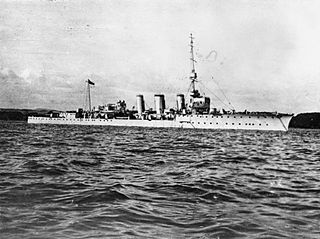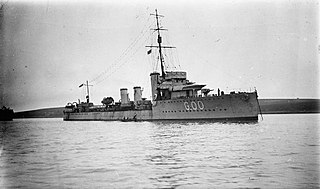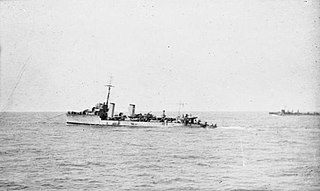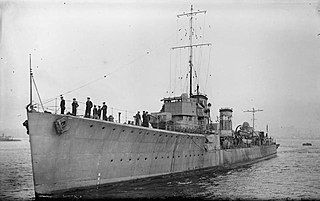Description
The Admiralty S class were larger and faster versions of the preceding R class. [2] The ships had an overall length of 276 feet (84.1 m), a beam of 26 feet 8 inches (8.1 m) and a deep draught of 9 feet 10 inches (3 m). They displaced 1,000 long tons (1,016 t ) at normal load. The ships' complement was 82 officers and ratings. [3]
The ships were powered by a single Brown-Curtis geared steam turbine that drove two propeller shafts using steam provided by three Yarrow boilers. The turbines developed a total of 27,000 shaft horsepower (20,000 kW ) and gave a maximum speed of 36 knots (67 km/h; 41 mph). Seafire reached a speed of 33.8 knots (62.6 km/h; 38.9 mph) from 28,464 shp (21,226 kW) during her sea trials. [4] The ships carried enough fuel oil to give them a range of 3,500 nautical miles (6,500 km; 4,000 mi) at 15 knots (28 km/h; 17 mph). [3]
The Admiralty S-class ships were armed with three single QF 4-inch (102 mm) Mark IV guns. One gun was positioned on the forecastle, the second was on a platform between the funnels and the third at the stern. They were equipped with a single QF 2-pounder (40 mm (1.6 in)) "pom-pom" anti-aircraft gun on a platform forward of the mainmast. They were also fitted with two rotating twin mounts for 21-inch (533 mm) torpedoes amidships and two 18-inch (450 mm) torpedo tubes, one on each broadside abaft the forecastle. [5]
Construction and career
Seafire, the first ship of her name to serve in the Royal Navy, [6] was ordered in June 1917 as part of the Twelfth War Programme from John Brown & Company. The ship was laid down at the company's Clydebank shipyard on 27 February 1918, launched on 10 August and commissioned in November. [7]
After commissioning, Seafire joined the 14th Destroyer Flotilla of the Grand Fleet. [8] She remained part of the 14th Flotilla in February 1919, [9] but following a post-war reorganisation of the Royal Navy's destroyer forces, Seafire was listed as part of the 7th Destroyer Flotilla at the beginning of March 1919. [10] Later that month, Seafire, commanded by Commander Andrew Browne Cunningham, later an Admiral of the Fleet, formed part of a force of two light cruisers and ten destroyers under the overall command of Admiral Walter Cowan, which was sent to the Baltic Sea as part of the British intervention in the Russian Civil War. Seafire sailed with only 60 per cent of her normal crew, in a reflection of the Royal Navy's manning problems after the end of the First World War. On 3 April, Seafire arrived at Liepāja, Latvia, and was then sent to Ventspils, which was threatened by the advancing Bolshevik forces. Seafire set up soup kitchens to help feed the starving population of Ventspils, using up most of her rations, before returning to Liepāja after four days. [11] [12] On 16 April, Baltic Germans staged a Coup d'Etat in Latvia. Seafire, still at Liepāja, prevented the Baltic German forces from capturing the transport Saratov, carrying a load of arms and ammunition intended for the armies of the new Baltic states, and helped members of the provisional national government to escape to Saratov, which was protected by the Royal Navy. [13] On 13 May, Cowan's flagship Curacoa was badly damaged when she struck a mine while on passage from Reval (now Tallinn) to Liepāja. Seafire escorted Curacoa back to Britain. [14] In June, Seafire was still listed as part of the 7th Destroyer Flotilla at Rosyth, now part of the Reserve Fleet. [15] Seafire transferred to the 5th Destroyer Flotilla in October 1919, [16] [17] but on 14 November, she was reduced to reserve at Devonport. [18]
She was one of the obsolete destroyers handed over to the shipbreakers Thos. W. Ward in part-payment for RMS Majestic on 14 September 1936, and was then broken up at Inverkeithing. [1]

HMS Castor was one of the Cambrian subclass of the C class of light cruisers. She saw service during the First World War and the Russian Civil War.

The S class was a class of 67 destroyers ordered for the Royal Navy in 1917 under the 11th and 12th Emergency War Programmes. They saw active service in the last months of the First World War and in the Russian and Irish Civil Wars during the early 1920s. Most were relegated to the reserve by the mid-1920s and subsequently scrapped under the terms of the London Naval Treaty. Eleven survivors saw much action during the Second World War.

HMS Cordelia was a C-class light cruiser built for the Royal Navy during World War I. She was one of six ships of the Caroline sub-class and was completed at the beginning of 1915. The ship was assigned to the 1st and 4th Light Cruiser Squadrons (LCS) of the Grand Fleet for the entire war and played a minor role in the Battle of Jutland in mid-1916. Cordelia spent most of her time on uneventful patrols of the North Sea. She served as a training ship for most of 1919 before she was recommissioned for service with the Atlantic Fleet in 1920. The ship was placed in reserve at the end of 1922 and was sold for scrap in mid-1923.

HMS Valkyrie was a First World War V-class flotilla leader of the Royal Navy. She was one of two destroyers ordered in July 1916 from William Denny & Bros. Ltd shipyard under the 9th Order for Destroyers of the Emergency War Program of 1916–17. She was originally to be called HMS Malcolm but was renamed before being completed. The name Malcolm was later assigned to another destroyer leader.

The fifth HMS Valorous, ex-HMS Montrose, was a V-class flotilla leader of the British Royal Navy that saw service in World War I, the Russian Civil War, and World War II.
HMS Violent was a V-class destroyer of the British Royal Navy that saw service in World War I and was in commission from 1917 to 1937.

HMS Bruce was the second of eight Admiralty type flotilla leaders of the Royal Navy. Built by Cammell Laird, Bruce was commissioned on 29 May 1918. During the First World War, she served with the 10th Destroyer Flotilla at Harwich. After the end of the war, Bruce spent several years in reserve at British ports, before spending almost 10 years based on the China Station. She was withdrawn from use because of her poor condition, and was sunk as a target ship on 22 November 1939.
HMS Tilbury was a S-class destroyer of the British Royal Navy that served during the First World War.
HMS Gentian was an Arabis-class sloop that was sent to assist the Baltic States and their fight for independence. While clearing mines on 15 or 16 July 1919, according to different sources, Gentian and the sloop HMS Myrtle both hit mines and sank with the loss of nine sailors.
HMS Myrtle was an Azalea-class sloop that was part of a Royal Navy squadron that was sent to assist the Baltic States and their fight for independence. While clearing naval mines on 16 July 1919 both Myrtle and HMS Gentian hit mines and sank. The two blasts killed nine sailors.
HMS Gabriel was a Marksman-class flotilla leader of the British Royal Navy, that took part in the First World War. The ship was built by Cammell Laird at Birkenhead, being launched on 23 December 1915 and entering service in July 1916. Gabriel served with the Grand Fleet, leading a destroyer flotilla and was later used as a minelayer. She survived the war, before being sold for scrap on in May 1921.

HMS Seymour was a Parker-class flotilla leader of the British Royal Navy. She was built by Cammell Laird during the First World War, being launched on 31 August 1916 and completing on 30 November that year. Seymour served with the Grand Fleet for the rest of the war, which she survived. The ship was sold for scrap in January 1931.

HMS Shakespeare was a Thornycroft type flotilla leader of the British Royal Navy. She was built by J I Thornycroft from 1916 to 1917 as the lead ship of her class, launching in July 1917 and completing in October 1917.
HMS Spenser was a Thornycroft type flotilla leader of the British Royal Navy. She was built by J I Thornycroft from 1916 to 1917 as the lead ship of her class, launching in September 1917 and completing in December that year.

HMS Serene was an S-class destroyer, which served with the Royal Navy. Launched on 30 November 1918 just after the end of the First World War, the ship was commissioned into the Reserve Fleet. Excluding a brief expedition to Latvia near to the end of that nation's War of Independence in 1919, the destroyer remained in reserve at Devonport until 1936. During this period, the condition of the destroyer deteriorated. Then, as part of a deal for the liner Majestic, Serene was sold to be broken up on 14 September.

HMS Sepoy was an S-class destroyer, which served with the Royal Navy during the First World War and the Russian Civil War. Sepoy was launched in 1918 and initially joined the Grand Fleet. After the Armistice that ended the First World War, the ship was briefly transferred to the Reserve Fleet before sailing to Tallinn in 1919 as part of the Royal Navy response to the fighting there. Sepoy rejoined the Reserve Fleet at the end of the year. In 1922, the destroyer served in the Mediterranean Sea. The ship was later allocated to the naval base in Hong Kong, arriving in 1929. During exercises the following year, a depth charge explosion killed six sailors. The destroyer was also damaged. Following the signing of the London Naval Treaty a few days later, Sepoy returned to the United Kingdom and, in 1932, was sold to be broken up at Newport, Wales.

HMS Sesame was an S-class destroyer, which served with the Royal Navy in the twentieth century. Launched on 30 November 1918 just after the end of the First World War, the ship was commissioned into the Reserve Fleet. A year later, the destroyer was sent to Latvia in support of the country's call for independence, arriving just at the cessation of that county's war of independence. Returning to the United Kingdom, Sesame was later equipped to act as a plane guard within the Home Fleet, with all armament removed and a davit fitted to rescue aircraft. The vessel remained in that configuration for a short time, but the London Naval Treaty sounded the death knell for the ship as it limited the destroyer tonnage that the Royal Navy could operate. As newer and more powerful destroyers entered service, Sesame was one of those retired, being sold to be broken up on 4 May 1934.

HMS Scotsman was an S-class destroyer that served with the Royal Navy during the Russian Civil War. The S class was a development of the previous R class, with minor differences, constructed at the end of the First World War. Scotsman was completed in May 1918 and joined the Grand Fleet for the last few months of the War. The destroyer then joined the British campaign in the Baltic, sailing as part of a detachment of ten destroyers under the command of Admiral Walter Cowan in March 1919. Scotsman provided military and humanitarian assistance to the Latvian cities of Liepāja and Ventspils in April 1919. On returning to the UK, the ship was placed in reserve, initially at Rosyth and later Devonport. The destroyer remained in reserve until, in July 1937, Scotsman was sold in part-exchange for the liner Majestic and broken up.

HMS Seabear was an S-class destroyer that served with the Royal Navy during the Russian Civil War. The S class was a development of the previous R class, with minor differences, constructed at the end of the First World War. Seabear was launched in December 1917 and joined the Grand Fleet for the last few months of the War. The destroyer then joined the British campaign in the Baltic, sailing as part of a detachment of ten destroyers under the command of Admiral Walter Cowan in March 1919. Seabear sailed to Tallinn in support of the Estonian War of Independence the following month. On returning to the UK, the ship was placed in reserve. The London Naval Treaty limited to number of destroyers that the Royal Navy could operate and, as new ships entered service, older vessels were retired. Seabear was sold in February 1931 and broken up.

HMS Searcher was an S-class destroyer that served with the Royal Navy during the Russian Civil War. The S class was a development of the previous R class, with minor differences, constructed at the end of the First World War. Searcher was launched in September 1918 and joined the Grand Fleet days after the end of the War. The destroyer then joined the British campaign in the Baltic, sailing as part of a detachment of ten destroyers under the command of Admiral Walter Cowan in March 1919. Searcher sailed to Tallinn in support of the Estonian War of Independence the following month. On returning to the UK, the ship was placed in reserve. In 1931, the destroyer resumed active service and joined the defence flotilla at Gibraltar, and, subsequently, the Mediterranean Fleet, accompanying ships like the aircraft carrier Glorious and the dreadnought Queen Elizabeth on cruises around the Mediterranean Sea. The vessel also took part in the naval review to celebrate the Silver Jubilee of George V in 1935. Searcher was sold to be broken up in 1938.












